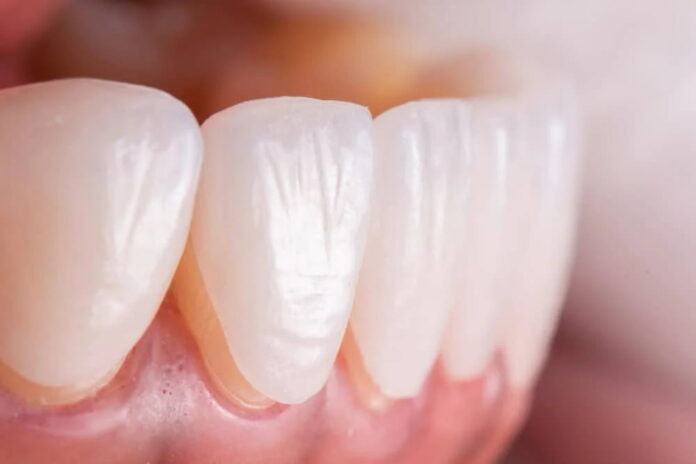Veneers are increasingly favoured for cosmetic dental improvements in the UK, presenting an opportunity for many to acquire an ideal smile. It is vital to consider such a choice from an informed standpoint, given the transformative results and the uplift in self-esteem it offers. Before embarking on this dental journey, one must grasp the potential hazards that accompany the process.
In this guide, we will discuss the potential risks of veneers, making sure those considering this dental route comprehend the advantages and the possible drawbacks.
What are Veneers?
Veneers are slender facades, typically fashioned from porcelain or composite resin, that mask the teeth’s anterior surface. They provide an aesthetic boost by delivering an even, whiter dental visage.
Individuals seek veneers for various purposes. Some are trying to get rid of stains resistant to standard whitening methods. Others aim to amend slight misalignments or interdental spaces without orthodontics. Moreover, veneers can mend chips or wear, revitalising the tooth’s appearance.
The application process involves the dentist removing a minuscule portion of the tooth enamel to accommodate the veneer, culminating in a natural fit. Although veneers can resolve a multitude of cosmetic dental issues, a comprehensive understanding of the process and its lasting consequences is essential.
Common Risks Associated with Veneers
A prevalent concern with veneers is the onset of heightened tooth sensitivity due to enamel removal during the procedure. Without this protective barrier, teeth may become more reactive to temperature variations, causing discomfort when consuming hot or cold items.
The irreversibility of enamel excision for veneer fitting is another serious consideration. Once removed, the enamel cannot grow back, meaning that veneers and other similar dental procedures should be considered a permanent decision.
Additionally, aesthetic discrepancies might arise if the veneers do not perfectly match the colour of the natural teeth. Although dentists aim for a match, mismatches can lead to dissatisfaction.
Furthermore, veneers that are not precisely fitted might lead to gaps that allow bacteria to thrive, potentially causing decay. This highlights the need for meticulous oral hygiene and regular dental visits post-veneer placement.
Serious Potential Risks of Veneers
Though they are generally safe when applied by a professional, veneers pose some severe, albeit infrequent, risks that are worth noting.
– A significant hazard is the excessive removal of tooth structure before veneer placement, potentially necessitating root canal treatment or leading to tooth loss.
– The gums may also react adversely to veneers, possibly resulting in inflammation, tenderness or occasional bleeding, which could compromise gum health and the cosmetic interface of the veneer and gum line.
– Veneers, while sturdy, are not impervious to damage. Excessive force or trauma may cause them to fracture or chip.
– As natural teeth shift with age, veneers may become misaligned, impacting the visual appearance and bite.
– The rare occurrence of a veneer debonding can be influenced by various factors, such as the quality of the bonding agent or the amount of enamel that is affected. Reattachment or replacement would then be necessary.
Awareness of these risks underlines the importance of selecting a reputable dental practitioner and ongoing dental appointments to make sure the veneers stay in good condition.
The Importance of Legal Advice If Veneers Go Wrong
Should veneer procedures result in suspected negligence, consulting a solicitor, particularly one versed in dental negligence, is important.
They can clarify your rights and advise on the validity of your claim, as well as helping you collate vital evidence and manage complex legalities. They will negotiate on your behalf to secure compensation for a negligent veneer procedure.
Additionally, solicitors offer support, directing clients to support networks or counselling services, mitigating the emotional impact of dental procedures gone awry.
In instances of presumed negligence, the solicitor becomes a vital advocate, ensuring legal redress and patient advocacy.
Tips for Minimising Risks
Proactive steps can lessen the risks associated with veneers, helping you achieve a favourable experience and outcome. Consider these guidelines for a secure process:
– Research your dentist: ensure the dentist’s credibility, especially in cosmetic dentistry and veneers. Reviews, referrals and credentials can be very helpful in this regard.
– Insist on thorough consultations: engage deeply during consultations to understand the risks and establish expectations. A competent dentist will address your queries and explain any concerns you may have.
– Adhere to post-procedure care: follow your dentist’s post-veneer care advice diligently.
– Keep up with dental appointments: continuous dental checks post-healing are crucial for veneer maintenance and early issue detection.
– Keep up on your oral hygiene: consistent brushing, flossing and mouth washing are pivotal for veneer longevity and decay prevention.
– Be conscious of your diet and other habits: avoid hard foods and discuss solutions for teeth grinding, like a night guard, with your dentist.
These measures, along with an open dialogue with your dentist, will enhance the positive aspects of veneers and make sure you are able to avoid the most common risks.
Read Also
- How Regular Exercise Transforms Senior Living for the BetterGetting older is something everyone experiences, but how we age can be greatly influenced by the choices we make. One of the best ways for seniors to stay healthy, happy, and independent is through regular exercise. Staying active isn’t just about fitness-it can improve nearly every part of life. From building strength and energy to… Read more: How Regular Exercise Transforms Senior Living for the Better
- The Importance of Mammograms and Early Detection for Aging WomenAs women age, taking care of their health becomes even more important. One key part of women’s health is regular breast screenings. Mammograms are a simple but powerful tool that can detect breast changes early. Early detection can save lives by finding problems before they become serious. For aging women, staying informed and proactive about… Read more: The Importance of Mammograms and Early Detection for Aging Women
- Understanding the Importance of Routine Health Screenings for SeniorsDid you know that the global routine health screening market is expected to reach $105.93 billion by 2033? This highlights the rising focus on preventive healthcare. As we age, our bodies go through many changes. Staying proactive about health becomes more important with time. Routine health screenings for seniors play a vital role in maintaining… Read more: Understanding the Importance of Routine Health Screenings for Seniors
- Why Modern Retirement Facilities Are Vital for Chronic Disease CareToday’s retirement feels different from the past. Modern communities are bright, active, and full of life. They give seniors comfort while also providing the care needed for health and safety. For those living with long-term conditions like diabetes or heart disease, these places bring both support and peace of mind. Here, life doesn’t slow down-it… Read more: Why Modern Retirement Facilities Are Vital for Chronic Disease Care
- Understanding Breast Cancer Risks and Signs in Older MenMany people associate breast cancer with women. But did you know that breast cancer risk in older men is a significant health concern? Although it is rare, men can develop this disease, especially in later years. Understanding the risks, symptoms, and necessary preventive actions can lead to earlier detection and treatment, ultimately improving survival rates.… Read more: Understanding Breast Cancer Risks and Signs in Older Men
- How to Choose the Perfect Eyewear for Your Face Shape and StyleEyewear has evolved far beyond a simple vision aid—today, it’s a bold statement of personality, professionalism, and fashion sense. Whether you’re selecting your first pair or updating your look, the right frames can enhance your features, elevate your confidence, and even influence first impressions. But with endless options available, how do you find the perfect… Read more: How to Choose the Perfect Eyewear for Your Face Shape and Style







